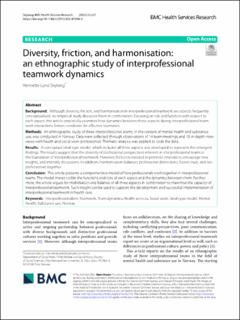| dc.contributor.author | Skyberg, Henriette Lund | |
| dc.coverage.spatial | Norway | en_US |
| dc.date.accessioned | 2022-09-19T08:18:12Z | |
| dc.date.available | 2022-09-19T08:18:12Z | |
| dc.date.created | 2022-02-10T09:52:43Z | |
| dc.date.issued | 2022-02-19 | |
| dc.identifier.issn | 1472-6963 | |
| dc.identifier.uri | https://hdl.handle.net/11250/3018752 | |
| dc.description.abstract | Background: Although diversity, friction, and harmonisation in interprofessional teamwork are aspects frequently conceptualised, no empirical study discusses them in combination. Focusing on risk and function with respect to each aspect, this article empirically examines how dynamics between these aspects during interprofessional teamwork interactions fosters conditions for efective teamwork.
Methods: An ethnographic study of three interprofessional teams, in the context of mental health and substance use, was conducted in Norway. Data were collected through observations of 14 team meetings and 18 in-depth interviews with health and social work professionals. Thematic analysis was applied to code the data.
Results: A conceptual ideal-type model, which includes all three aspects was developed to represent the emergent fndings. The results suggest that the diversity of professional perspectives inherent in interprofessional teams is the foundation of interprofessional teamwork. However, friction is needed to promote innovation, encourage new insights, and intensify discussions. In addition, harmonisation balances professional distinctions, fosters trust, and ties professionals together.
Conclusion: This article presents a comprehensive model of how professionals work together in interprofessional teams. The model makes visible the functions and risks of each aspect and the dynamics between them. Furthermore, the article argues for mobilisation and balance of all three aspects in combination to maximise the capacity of interprofessional teamwork. Such insight can be used to support the development and successful implementation of interprofessional teamwork in health care. | en_US |
| dc.language.iso | eng | en_US |
| dc.publisher | BMC | en_US |
| dc.relation.ispartofseries | BMC Health Services Research;22, Article number: 227 (2022) | |
| dc.rights | Navngivelse 4.0 Internasjonal | * |
| dc.rights.uri | http://creativecommons.org/licenses/by/4.0/deed.no | * |
| dc.subject | Interprofessionalism | en_US |
| dc.subject | Teamwork | en_US |
| dc.subject | Health services | en_US |
| dc.subject | Social work | en_US |
| dc.subject | Ideal-type models | en_US |
| dc.subject | Mental health | en_US |
| dc.subject | Substance use | en_US |
| dc.title | Diversity, friction, and harmonisation: an ethnographic study of interprofessional teamwork dynamics | en_US |
| dc.type | Peer reviewed | en_US |
| dc.type | Journal article | en_US |
| dc.description.version | publishedVersion | en_US |
| dc.rights.holder | © The Author(s) 2022 | en_US |
| dc.source.articlenumber | 227 | en_US |
| cristin.ispublished | true | |
| cristin.fulltext | original | |
| cristin.qualitycode | 2 | |
| dc.identifier.doi | https://doi.org/10.1186/s12913-022-07596-0 | |
| dc.identifier.cristin | 1999818 | |
| dc.source.journal | BMC Health Services Research | en_US |
| dc.source.volume | 22 | en_US |
| dc.source.issue | 22 | en_US |
| dc.source.pagenumber | 1-12 | en_US |

